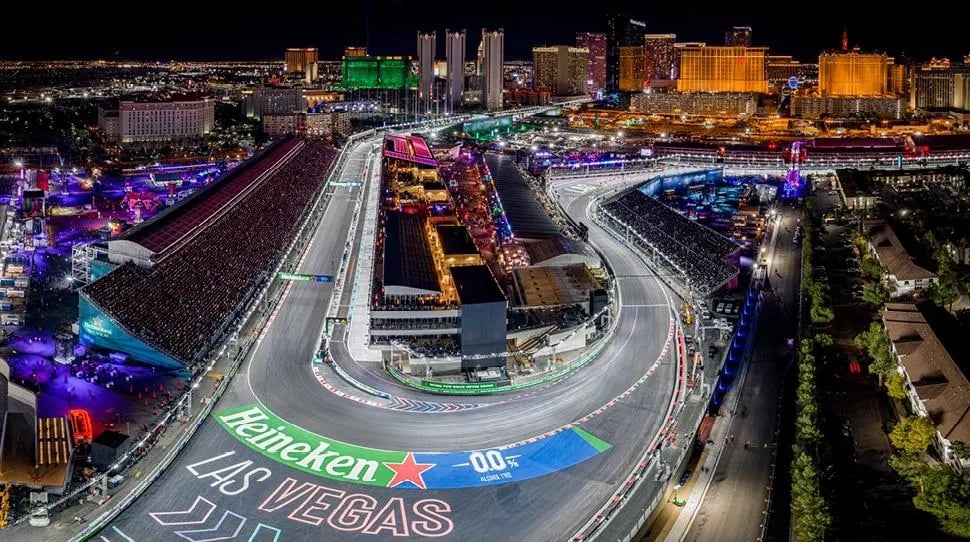Norris Dominates Vegas Qualifying Amidst Safety and Championship Drama
A report on the dramatic Las Vegas Grand Prix weekend, where Formula One championship leader Lando Norris secured pole position in a wet qualifying session. The article details the session's results, the disruptive track safety issues caused by shifting manhole covers during practice, and the surrounding championship stakes, including the FIA's plan to close a controversial engine cost cap loophole.
SPORTS
Muhammad Umaish
11/22/20253 min read


Norris Captures Pole in Rain-Soaked Las Vegas GP Qualifying Amidst Track Controversy
The build-up to the Las Vegas Grand Prix was defined by both on-track speed and off-track drama, culminating in a thrilling, rain-affected qualifying session where McLaren’s Lando Norris clinched pole position. The current Formula One championship leader expertly navigated the wet conditions, recording a time of 1 minute, 47.934 seconds, securing his third consecutive pole. He finished nearly three-tenths of a second ahead of Red Bull’s Max Verstappen and Ferrari’s Carlos Sainz.
Norris’s primary title rival, teammate Oscar Piastri, settled for fifth place after an unfortunate moment late in the session. The Australian went wide at the Turn 12 run-off area during his final attempt following a close battle with the Racing Bulls machine of Isack Hadjar. The top grid positions were rounded out by Mercedes’ George Russell in fourth, despite Russell having paced both Q1 and Q2 in the worst of the weather. The top ten included Liam Lawson (Racing Bulls), Fernando Alonso (Aston Martin), Hadjar, a ninth-place finish for Charles Leclerc (Ferrari)—who also struggled with the exit of Turn 12—and Pierre Gasly (Alpine).
The challenging conditions claimed several high-profile victims earlier in qualifying. Williams’ Alex Albon was eliminated in Q1 after a crash at the exit of Turn 16, which resulted in a broken front-right suspension. Mercedes’ Kimi Antonelli, Sauber’s Gabriel Bortoleto, and Red Bull’s Yuki Tsunoda were also eliminated in the first segment. Most notably, seven-time World Champion Lewis Hamilton finished last of the 20 runners, struggling significantly to extract performance from his car on the wet tire compound.
Practice Marred by Drain Cover Drama
The on-track action leading up to qualifying was marked by disruption and a familiar safety concern. The second free practice (FP2) on Thursday was twice halted due to a shifting manhole cover. Track action was initially stopped after a marshal noticed a potential issue near Turn 17 on the floodlit street circuit. After a 15-minute delay, the session was brought to a definitive, early end when the governing body, FIA, confirmed that on-site personnel reported the same drain cover was still moving as cars passed over it. This required a precautionary check and evoked memories of the 2023 inaugural event, where a loose manhole cover notoriously wrecked Carlos Sainz’s Ferrari.
Despite the limited running due to the interruptions, Lando Norris still managed to top the timesheets in FP2 with a best time of 1:33.602 on soft tires. He finished marginally ahead of Kimi Antonelli, who was just 0.029 seconds slower. The session's competitiveness was evident, although several drivers, including Max Verstappen (who finished ninth on medium tires), were unable to get in a crucial fast lap on the soft compound. Charles Leclerc, who had set the pace in FP1, finished third in FP2 but suffered a suspected gearbox failure near the end of the session, stopping on track.
Norris, who had earlier grazed a wall without damage in the initial practice session (where he was sixth), reported making solid progress. “We didn't manage to get too much from FP2, given the disruption, but we did get a slightly better feeling than in FP1,” Norris stated. However, the team had approached the weekend with caution. McLaren CEO Zak Brown had previously expressed concern, telling Sky Sports that the Las Vegas circuit's characteristics were not expected to favor the team.
Championship Battle and Regulation Scrutiny
Heading into the final stretch of the season with three races remaining, the championship narrative remains intense. Lando Norris holds a 24-point advantage over his teammate Oscar Piastri, while Max Verstappen—despite recent struggles—remains a threat, sitting 49 points off the lead.
The competitive nature of the title fight has bled into regulatory discussions, particularly concerning engine allocation and the sport’s cost cap. The FIA recently announced plans to close a loophole in the 2026 technical regulations concerning engine replacements. This change stems from a high-profile incident in Brazil, where Red Bull fitted Max Verstappen’s car with a brand-new Honda power unit, resulting in a pitlane start but a subsequent podium finish.
The issue arose because engine changes necessitated by reliability concerns are excluded from a team’s cost cap expenditure. McLaren, led by principal Andrea Stella, questioned whether the Red Bull engine swap was truly for reliability or for a strategic performance advantage. Stella argued that if the change was for performance, the expense should be factored into the cost cap.
Nikolas Tombazis, the FIA's single-seater director, acknowledged the difficulty the governing body faces in policing such changes, conceding that the FIA currently “don’t feel we have the expertise to argue with them whether it’s really a reliability or strategic change.” This admission underscores the necessity of the upcoming rule revamp, which aims to ensure fair competition and fiscal transparency by strictly controlling how power unit components are allocated and costed moving forward.
As the teams prepare for the race, the atmosphere remains highly charged, blending the spectacle of the Las Vegas circuit with the high stakes of a tightly contested world championship, complicated by track safety concerns and ongoing regulatory debate.
